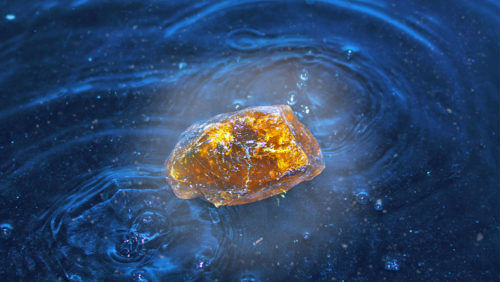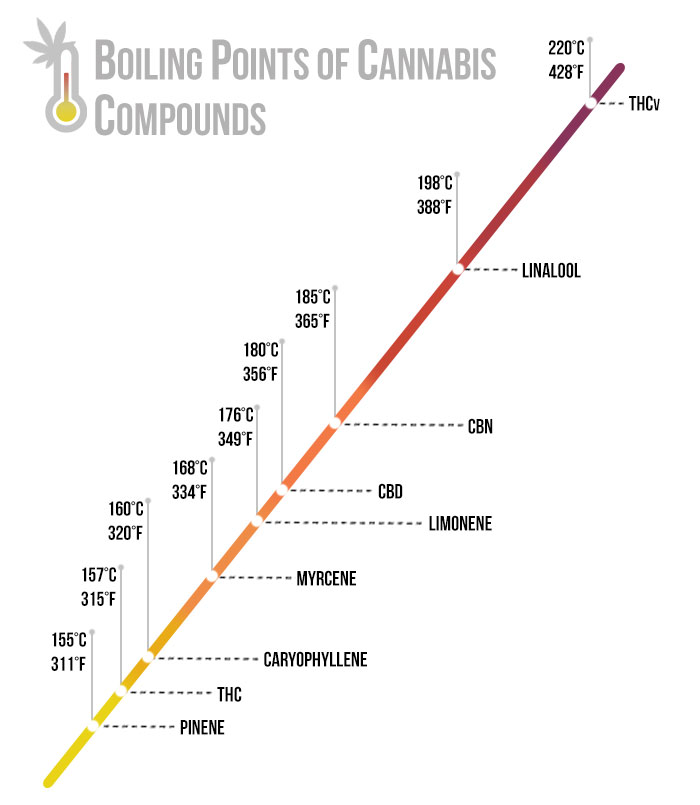As a part of our series on cannabis concentrates, this article will provide you with all the necessary knowledge on rosin.
Both the demand and quality of rosin is on the rise, especially in the US where dispensaries are ruling the legal cannabis landscape.
And this is a great thing for us because the high levels of cannabinoids and terpenes in concentrates are unprecedented.
The purity of rosin extraction method also separates it from other concentrates as it doesn’t use anything except plant materials.
What is rosin?

Rosin is a cannabis concentrate that’s made through an extraction technique which involves applying pressure and heat on fine hash.
As such, rosin has extremely high levels of cannabinoids and terpenes.
Several important factors differentiate rosin from other concentrates:
- Purity — which is a result of not using any type of solvent to separate cannabinoids and terpenes from the plant, but instead only heat, pressure and sift bags with microscopic openings.
- No solvent residue — as it’s not used in the process of making it. Many other concentrates have to go through the solvent purification process and oftentimes there is a lot left on the product.
- Price of production.
- Modularity — possibility to manipulate rosin into different textures and consistencies such as shatter, wax and crumble.
How potent is rosin?
The potency of all concentrates absolutely depends on the material used for making them.
What’s also paramount in this equation is the quality of the sifts used in the extraction process, because this also determines how much THC rosin will end up having.
Rosin usually has around 70% THC but some yields can even have up to 80%.
How to make rosin?
Unlike other methods of extraction, which rely on the use of highly combustible and overtly dangerous solvents (butane, as in BHO or butane hash oil, or propane), professional rosin creation doesn’t involve anything other than a machine press which heats up the hash to a very moderate temperature.
Because of this, the overall risk of injury is greatly diminished, especially for cannabis connoisseurs who’re interested in making their own personal extracts in the privacy of their home.
Making rosin is also very cost-effective when we compare it to other concentrates, because other extraction methods include the cost of installing a professional ventilation system, and demand for a proper storing of dangerous solvents.
When we combine safety with a very reasonable price, we can objectively determine that pressing rosin is really a superior extraction method as far as concentrates go.
There are two different methods of making rosin, and the first is a DIY inexpensive version of the more serious, professional and far pricier counterpart.
To find out how you can make rosin with just a hair straightener and some parchment paper hop over to this article, and follow the guidelines.
The more complicated method will require you to purchase a press that’s designed exclusively for the task of making resin, which will set you back anywhere from $3000 to $10.000.
This is quite a sum, but still a lot cheaper than any closed-loop extraction system used for making solvent-based extracts.
There are some less expensive press units that rely on manual pressure, but create heat on their own, and they will set you back anywhere from $300 to $1000.
If you’re considering investing in equipment for making rosin, it’s essential to research recommended rosin presses to ensure you choose the right one for your needs.
Let’s see how exactly these presses work.
The first thing that you need to do is turn your sift filter micron bags inside out. They come in many variations (such as 25u, 45u, 73u, 120u,160u etc), and these will determine the purity of your rosin.
You’ll also need two identical bags, which will go one over the other. Make sure you don’t have any hairs or other tiny contaminants in the bags.
Use a funnel to pour the hash into the first micron bag. For best results the hash needs to be created with the dry sifting method and afterwards sieved in a cold room or a freezer.
Dry sift is the use of fine-mesh screen to manually separate the finer and smaller parts of the cannabis plant from the unimportant plant material. These smaller particles include only cannabinoids and trichomes, and the end product of dry sifting has a very grainy and coarse texture.
If you want to store the dry sifted hash before using it, use the exact same technique as storing the newly created rosin for longer periods.
When you get it out of the cold room (or a fridge / freezer) high quality hash will have a very powdery feel to it, and will quickly start greasing up on room temperatures.
This is something you want to avoid when making rosin.
Once the micron sift bag is filled (you should fill about 80% of it), place it near the press for 2 to 5 minutes, so the hash starts to gel a bit, as this will make the end product better.
You should also place the bottom part of the mold to warm up on the press (82C° – 180F° or less), also for 2 to 5 minutes. It should feel warm to the touch)
Next even out the hash in the micron pouch so it becomes as evenly distributed as possible.
Fold the first pouch and insert it into the other micron bag, with the folded side going in first. Make sure that the side seams align perfectly.
Place the parchment paper over the press where the newly created rosin will pour over, and perform the so called stamping before pressing the hash completely.
This is done so the hash evens out additionally, and once that’s done you’re ready for the actual pressing.
The temperature of the plates should be about 82C° (180F°), and make sure you don’t go over 155C° (240F°), because some terpenes found in cannabis evaporate on temperatures higher than this.
You don’t want to get rid of any terpenes as they play off cannabinoids for a more potent effect, and some even have therapeutic effect by themselves.
Hash that was made from a strain that is rich in terpenes will result in a rosin that comes out of the press in a thicker less liquid form (like budder or batter), than rosin from a strain that had lower terpene levels.
Also if left at room temperature most rosins will quickly become less gooey and begin to harden.
To sum it up every individual strain will result in a rosin that has its unique density and texture, which are directly dependent on the cannabinoid and terpene levels. Other factors include the age of the material used, and how the plant was grown and harvested.
How to smoke rosin?
Whether you’re using a dabbing rig or a vaporizer capable of vaporizing extracts, you have a couple of options available when consuming rosin.
You can either vaporize it with lower temperatures, which is a better option for really feeling the terpene signature of that specific rosin, or you can go with higher temperatures where the vapor will be bigger and thicker.
Lower temps also slightly delay the psychoactive effects of rosin, while with higher temps the rosin instantaneously hits you like a ton of bricks.
What’s also very important when choosing a desired temperature is the so called vaporization point for both cannabinoids and terpenes, because if you go lower than these temperatures, you won’t experience the complete cannabinoid / terpene profile of that particular rosin.

With vaping It’s best to always go over these temperatures a little bit, just to ensure that every active chemical compound fully evaporates.
For rosin this is somewhere between 250C° (500F°) and 282C° (540F°), because this solventless extract doesn’t go through the process of removing fats and lipids from it, and this makes it more delicate and thus requires less heat in comparison to the concentrates that use solvents in their creation, like BHO for example.
Because rosin doesn’t require dewaxing like the hydrocarbon extracts, you can expect some residue after your dabbing / vaping session, and this is especially something to keep in mind when using vaporizers, as the residue will get your device really sticky and resinous.
To avoid any issues with your device make sure to clean it after every rosin session, using isopropyl alcohol (ISO) and cotton swabs.
How to store rosin?
In order to preserve the potency and freshness of your rosin you have to store it properly.
There are a couple of ways to achieve this, and they differ if you plan you to store the extract for a shorter, or a longer period.
It’s actually simpler to store concentrates than flowers, and just like with buds, there are four factors to be considered; heat, moisture, air and light—you want to avoid all these as much as you can.
Short term rosin storage
Depending on the strain it was created from and the quantity of terpenes in the end product, your rosin will be more or less gooey, but it will most likely be too sticky and liquid for glass containers and jars.
The issue with glass is that you won’t be able to remove all the resin from it, and cleaning the jar is also going to be a nightmare.
It’s much better to use silicone containers for the short term storage of rosin, as it’s much easier to get the resinous remains off of them.
This is a great way to preserve your rosin for up to 7 days but no longer: Silicon containers aren’t air tight, and long term exposure to air will lessen the potency of your rosin, due to oxidation.
Just make sure to get medical grade silicone so you don’t end up with any unwanted particles in your resin.
Long term rosin storage
For longer periods, you should cover your rosin in parchment paper, place it in a sealed food bag and then into an airtight container.
The ones that remove the remaining air after sealing are preferable. The final step is to put the container in a dark, dry and relatively cool place.
For people living in really warm climates the best long term solution is to store the rosin in a refrigerator or a freezer. Follow all the steps mentioned above and remember that your biggest enemy is humidity, which is avoided by vacuum-sealing your extract.
Another very important factor to watch out for is letting your airtight container reach room temperature once you get it out of the refrigerator / freezer.
If your open the container while it’s still cold, you actually risk contaminating your rosin.
This will make dabbing less pleasurable because of the water trapped in your extract, and can even cause damage to your vaporizer, in case a large quantity of moisture managed to enter your rosin.
To avoid all of this just let the container sit in room temperature for 10 to 15 minutes.
Are concentrates the future?
Even though they are currently mostly used for recreational purposes, cannabis concentrates have a great potential for people who are consuming pot for specific medical conditions.
The thing that hinders the use of canna-extracts for medicinal purposes is that no scientific studies so far used these high-concentrated forms of cannabis to analyze their effects on medical issues.
What makes them extremely promising in my opinion is all the anecdotal evidence of RSO (Rick Simpson Oil), which is basically just another variation of a cannabinoid-packed cannabis concentrate, with THC levels of over 90%.
In the case of RSO it is evident that larger concentrations of both cannabinoids and terpenes seem to have a much more beneficial effect on numerous ailments and diseases, comparing to the consumption of buds.
This is because the amount of these active chemical compounds entering our body at once is far greater when using high concentrated oils and extracts.
I’m uncertain if the medical establishment is deliberately avoiding performing human studies with these potent cannabis extracts, but as far serious conditions go, concentrates seem like a far better solution, as they are the absolute same thing as pure cannabis, but in much higher concentrations.
Luckily when full blown legalization hits Canada, both medical and recreational users will be able to buy and make their cannabis extracts and derivatives, and mainstream science will hopefully pick up the pace in the meantime.






Lisa Freeman January 2, 2019 at 1:21 pm
I am a part of conscious conference that is taking place on February 13th 2019 called Anarchawakening. It takes place at a beautiful beach retreat center right on the Pacific Ocean called https://www.bambuddha.com.mx/ Before and after our conference we are holding retreats. These retreats will be centered around Ayahuasca. Our conference is about bringing alternative medicines out into the open and the importance of healing one’s self for the bettering of the world. It starts with us. During our conference on Wednesday the 13th all of the shamans and facilitators will be available for a meet and greet. We are planning workshops as well. We are working towards having all these areas covered at our festival. Yoga Trauma yoga Breath work Reiki Massage/yoga Chiropractor Essential oils Aura reading Tarot cards Belly dancing Eye gazing Laughter therapy Hug therapy Cacao ceremonies Cha dao tea Colonics detox clinic *Touch lab- hug, massage, yoga *Inflammation clinic- food medicine (me) morning tonics Colonics detox clinic Homeopathic doctor Acupuncturist Kratom Here is our website https://www.anarchawakening.com/ Let me know what you think. We don’t have a cannabis representative yet. This event is run by anarchists voluntarists, who believe and practice the NAP. We don’t live in the Empire any more and are well aware of the Matrix.
Marco January 8, 2019 at 10:06 am
Your conference sounds really wonderful Lisa, unfortunately I'm currently way too tied up with Greencamp to participate. I truly respect what you are doing, best of luck with everything.